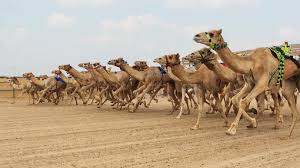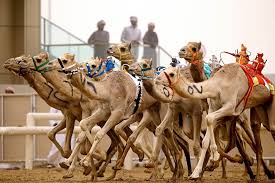The National Sport of the UAE
Every country has a sport that is deeply connected to its culture, history, and people. For the United Arab Emirates, that sport is camel racing. Far more than just a competition, camel racing is a symbol of heritage and tradition that has been passed down for generations. It is celebrated not only as a thrilling sport but also as a reminder of the nation’s roots in the desert, where camels played a vital role in survival, transportation, and community life.
A Tradition Born in the Desert
Camel racing began centuries ago, long before the modern UAE was established. Camels were once known as the “ships of the desert,” helping Bedouins travel across harsh landscapes. Over time, people began to hold informal races during festivals and special gatherings, where the strength and speed of these animals were admired.
What started as a pastime quickly became a cultural practice that represented honor, pride, and community spirit. Families gathered to celebrate races, and owners would proudly present their best camels, showcasing the bond between humans and these majestic animals.

Evolution into a National Sport
With the formation of the United Arab Emirates in 1971, camel racing evolved from a traditional pastime into a formally recognized sport. The government made conscious efforts to preserve this important part of Emirati culture by investing in modern racetracks, facilities, and organizations dedicated to camel racing.
Today, camel racing is officially recognized as the national sport of the UAE. Races are organized on professional tracks, and they attract not only locals but also international spectators who want to witness this unique experience. Prizes, trophies, and recognition further elevate the status of the sport, giving camel racing a permanent place in the national identity of the UAE.


The Role of Technology in Modern Camel Racing
Camel racing in the UAE is not stuck in the past. The sport has embraced modern technology while still keeping its heritage alive. One of the biggest transformations was the introduction of robot jockeys, replacing the use of young children as riders. This innovation was both a cultural and humanitarian step forward, ensuring safety while preserving the excitement of the sport.
Robot jockeys are lightweight, remotely controlled, and designed to ensure that camels perform at their best without any harm. This technological leap highlights how the UAE balances tradition with progress, making the sport more ethical and sustainable.
Festivals and Celebrations
Camel racing is more than just a competition—it is a celebration. Races are often held during major festivals and national holidays, especially around the time of the UAE National Day and other cultural events. These gatherings bring together families, communities, and even visitors from abroad who want to immerse themselves in Emirati traditions.
The races are often accompanied by music, traditional food, and cultural performances, making them a complete experience of the UAE’s heritage. For many Emiratis, attending a camel race is not just about watching the sport but about feeling connected to their identity and their ancestors.
The Economic and Cultural Impact
Camel racing also plays a significant role in the UAE’s economy and tourism industry. Camel breeding, training, and racing have become professional industries, creating opportunities for breeders, trainers, and organizers. The sport also attracts tourists who are curious to experience a tradition that is unlike anything found in most parts of the world.
Culturally, camel racing reinforces a sense of pride among Emiratis. It is a reminder of the resilience of their ancestors and the importance of preserving traditions in a rapidly modernizing world. By keeping this sport alive, the UAE demonstrates that heritage can thrive alongside modernity.
Camel Racing as a Family Tradition
For many Emirati families, camel racing is a tradition that connects generations. Parents and grandparents pass down stories of races from their youth, while children grow up attending events and learning the value of their heritage. Owning and racing camels is often a family affair, where every member contributes to training, caring, and preparing for competitions.
This deep connection makes camel racing more than a sport—it is a living tradition. Families take pride in their camels, naming them, caring for them, and celebrating their victories as shared achievements.
The Thrill of the Race
The atmosphere during a camel race is electric. As the camels line up at the start, spectators cheer with anticipation. The sight of dozens of camels sprinting across the desert track, their long legs moving in perfect rhythm, is a breathtaking experience. The excitement builds as they approach the finish line, and the energy of the crowd reflects the importance of the sport in Emirati life.

For those who witness it for the first time, the sport may seem unusual compared to football or cricket, but its intensity and cultural depth leave a lasting impression.
Preserving the National Identity
In a country known for its futuristic skyscrapers, world-class shopping malls, and cutting-edge technology, camel racing stands as a proud symbol of tradition. It reminds people of where the nation came from and what values it holds dear. The UAE has shown that even in the face of rapid modernization, heritage does not have to be forgotten.
By recognizing camel racing as its national sport, the UAE has made a statement about the importance of cultural preservation. It is a way of telling the world that while progress is important, roots must never be abandoned.
Global Recognition of Camel Racing
Camel racing is no longer limited to the UAE. The sport has gained recognition in other parts of the Middle East, North Africa, and even internationally. The UAE has positioned itself as a leader in promoting camel racing, hosting international events that draw participants and spectators from across the globe.
These efforts not only showcase Emirati culture to the world but also strengthen cultural ties with other nations that share similar traditions.
Camel Racing in the Future
Looking ahead, camel racing will continue to be a cornerstone of Emirati identity. With ongoing investment in technology, facilities, and ethical practices, the sport is expected to attract even more global attention. Younger generations are becoming more engaged, ensuring that the tradition will not fade away.
The UAE’s commitment to balancing progress with tradition guarantees that camel racing will remain a vibrant part of the country’s cultural fabric. Future developments may even bring new ways for audiences worldwide to experience the sport, whether through broadcasting, virtual reality, or cultural exchanges.
Conclusion
The national sport of the UAE, camel racing, is more than just a race. It is a living connection to the desert, a celebration of heritage, and a symbol of unity for the Emirati people. From its humble beginnings among Bedouins to its modern form with robot jockeys and international recognition, camel racing tells the story of a nation that treasures its past while embracing the future.
Through this sport, the UAE reminds the world that progress and tradition can exist side by side, and that true identity lies in honoring one’s roots. Camel racing will continue to inspire pride, strengthen communities, and carry forward the cultural spirit of the UAE for generations to come.
Do follow UAE Stories on Instagram
How UAE’s National Guard Protects the Nation With Unmatched Strength















